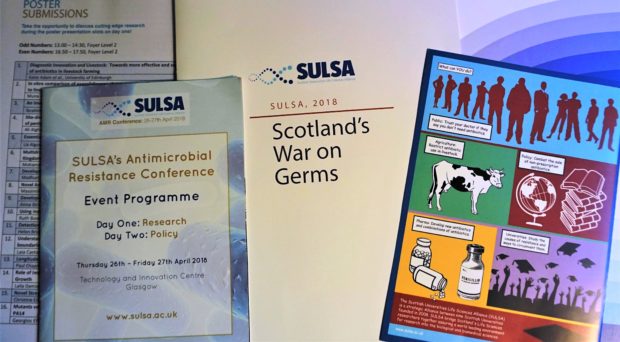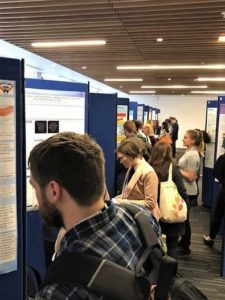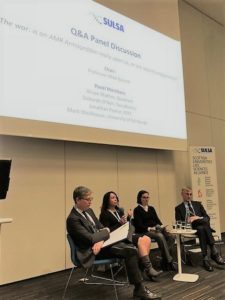
Representatives from academic research, industry, funding bodies and government from Scotland and beyond met in Glasgow last month to share their expertise on antimicrobial resistance (AMR). The conference, organised by the Scottish Universities Life Sciences Alliance (SULSA), aimed at facilitating collaborations and common approaches to tackle what is recognised internationally as a fundamental threat to global health.
Scotland, with its well-established and highly respected antimicrobial research and product development landscape, has already begun to grapple with the problem of AMR and is now trying to further boost research and innovation in the field. The meeting afforded delegates the opportunity to discuss issues related to AMR (both from a clinical and a research point of view) and to have an overview of the progress being made.
The search for new antimicrobials
Since the discovery of penicillin by the Scottish-born Alexander Fleming in 1928 we have taken antibiotics for granted. However, things are now changing. A worrying rise in drug resistant bugs means we risk losing these “wonder drugs” which protect us from potentially life-threatening infections.

This state of affairs calls for reinvigorated efforts in the pursuit of novel antimicrobials, an area of research which has suffered a pharma “discovery void” since the late 1980s. New weapons are needed to fight resistant pathogenic bacteria but also other nasty microorganisms such as fungi like Candida auris, the “MRSA of mycology”. Unfortunately, as pointed out by Professor Neil Gow from the University of Aberdeen, fungal infections attract little attention or funding, despite affecting over a billion people globally and causing twice as many deaths as malaria.
Antibacterial drug discovery is equally challenging. Researchers have to take into account the multiple mechanisms that bugs have evolved to escape being killed, as explained by Professor Ian Gilbert, from the University of Dundee. These defence mechanisms include efflux pumps and the formation of biofilms, which support persisters: metabolically inactive bacteria either resistant or tolerant to drugs.
Despite the difficulties, some innovative tools are being developed. Professor Colin Suckling (Strathclyde University) presented his new class of anti-infective minor groove binder compounds that bind to DNA of bugs, currently in trial against Clostridium difficile by MGB-Biopharma. A completely different approach was illustrated by Dr Deborah O’Neil (Novabiotics) who is targeting infection by boosting the host side. Two of her re-engineered human immune defence molecules are already in trials and more are in preclinical development.
In the near future novel medicines might be discovered among the unknown metabolites of actinomycetes, the same bacteria that produce most of the antibiotics we currently use, as shown by the work of Dr Katherine Duncan (Strathclyde University).
A One Health problem with unresolved dynamics
The introduction of novel antimicrobials is only one part of the solution to combat AMR. History tells us that for every new antibiotic introduced, resistance is soon to be found. AMR is found everywhere in our environment as bugs evolve these defences to compete with other microbes.
Humans, farm animals and the environment interact with each other and their respective bacterial partners. Bacteria, their mobile genetic elements and drug residues can move in between these three interconnected players in ways we are only starting to unravel. AMR is a quintessential One Health issue. Only an integrated approach, with interventions in all three of these domains, will have an impact, as Professor Mark Woolhouse (University of Edinburgh) stressed.
The diagnostic problem
When it comes to the clinic the first hurdle is the correct and prompt identification of the infectious agent and its potential drug resistance spectrum. This information is needed to allow the selection of the appropriate treatment, avoiding the misuse of antibiotics which is associated with resistance development.
However, as Dr Till Bachman, from the University of Edinburgh, pointed out, rapid diagnostics is still an unmet need in clinical microbiology. He and his team are working on several projects aimed at shortening the time required for a diagnosis that currently can take up to 72 hours. Professor Stephen Gilliespie from the University of St Andrews reiterated the clinical need stressing how in GP surgeries and clinics most diagnostics fail to make an impact because they take more than the ideal 30 minutes for a result.

So far, most of our data on AMR is based on reported clinical cases with little known on the extent of resistant bacteria in the general population.
Despite the global recognition of AMR as a problem and the launch of initiatives such as GLASS and Global PPS we have no clear picture of AMR spread. As Professor Dilip Nathwani (University of Dundee) emphasised, better surveillance data are required.
Fair action and education
Equity and social issues must also be part of the equation when tackling AMR. Jonathan Pierce from the MRC said “AMR is ‘glocal’”: a shared problem with different local drivers. Each driver will need to be considered when planning interventions such as restrictions on the use of antibiotics. On the other hand, access to antibiotics for those who cannot afford them should be an international priority.
Finally, education of not just medical staff and veterinarians, but also of the general public on the topic of AMR and the responsible use of antibiotics is essential as part of the effort to prolong the life span of these life-saving drugs.

Comments